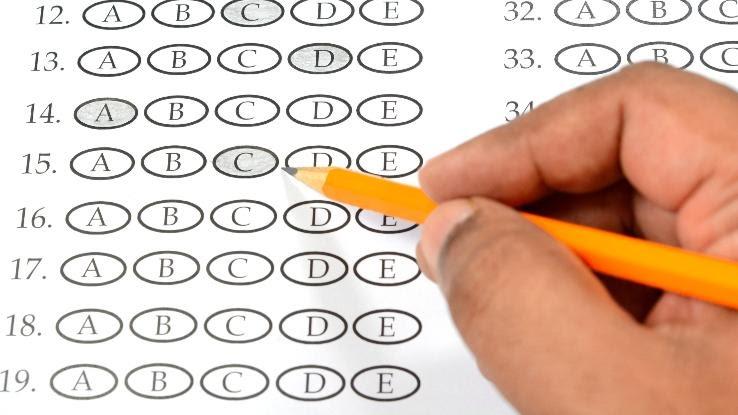What Are the Advantages and Disadvantages of Teacher-Made Tests?

The primary advantage of a teacher-made test is the ability the teacher has to design a customized test that matches the learning goals and content of the class. A key drawback is that teacher-made tests are often narrow in scope and aligned only with the individual teacher’s goals. In this article, we’ll take a look at what teacher-made tests are and examine their advantages and drawbacks when compared to standardized tests.
What Is a Teacher-Made Test?
Unlike standardized tests, which are mass-produced by someone outside of the school, teacher-made tests are exactly what they sound like: tests the teachers themselves create and write.

Teacher-made tests offer a variety of advantages for both the students and teachers alike. However, they also present a few challenges that are important to take into consideration.
Advantages of Teacher-Made Tests
One of the main advantages of teacher-made tests is that teachers are able to specifically shape the exam around the material they’ve taught during their lessons. When a teacher plans to use a test someone else made, it’s only fair for them to structure their lesson plans around the material that the test covers.

By making a test of their own, however, they have the freedom to design their own lesson plans in a way that reflects their particular teaching style and the concepts they want to stress the most. For instance, if the test results identify a concept that a large number of students may be struggling with, a teacher then has the freedom to really hone in on that topic and, later, present a test that covers it much more specifically.
Teacher-made tests also offer educators the chance to expand upon the information presented in a textbook. Teachers might want to incorporate guest speakers, field trips or extra reading assignments into their lessons. Being able to design their own tests gives them a chance to include questions about these extra teaching tools.
Most importantly, a teacher tends to know their students far better than an outside publishing company. By controlling the format of their tests, they can take into account the different learning styles of their students in order to more accurately assess how much the students have learned.
Disadvantages of Teacher-Made Tests
One of the disadvantages of teacher-made tests is the fact that some teachers aren’t as well-versed as others when it comes to constructing them. For a teacher-made test to be effective, a teacher must put a great deal of time into ensuring that it accurately assesses the students’ comprehension of information the teacher has focused on and that it takes different learning styles into account.

Additionally, teacher-made tests can only measure a student’s performance against other students in the same class. Standardized tests, on the other hand, are made to compare a student’s performance with other students in the same region or country. Standardized exams tend to have been rigorously tested on a large number of sample students in order to make sure that they don’t include unreliable or confusing questions.
Last but not least, many colleges and states require students to take standardized tests such as the SAT and ACT at some point during their education. So while teacher-made tests can be great in certain instances, a teacher should never exclude any concepts that their students will later be expected to know. Familiarizing students with standardized tests at a younger age can help them become more comfortable with taking them later on.
Types of Teacher-Made Achievement Tests
Teachers have a variety of options when composing their own tests for their students. Different types of teacher-made tests include:

- Multiple choice
- Short answer
- Fill in the blank
- True or false
- Matching questions
- Essay
- Open-ended questions
One of the advantages of having so many options when compiling a test is that teachers are able to best fit the test style to their subject. They can also take into account their students’ strengths as far as what testing style tends to work best for a particular class.
Teacher-Designed Assessments Examples
One of the benefits of teacher-made testing is that the teacher is free to use as many or as few of the question styles listed above as they like. Let’s take a look at examples of each to give you a better idea of how and when they’re effectively used.

Multiple Choice
Multiple choice answers tend to be easy to grade and leave little room for confusion or interpretation.
Example: The capital of California is:
(A) Sacramento
(B) Los Angeles
(C) San Diego
Short Answer
Students are asked to answer a question with a single word or sentence. This has the benefit of removing the possibility of guesswork.
Example: What is the capital of California?
Fill in the Blank
Similarly to short answer questions, students are presented with a sentence with one word left out. They must fill in the missing word to make the sentence a true statement.
Example: ______ is the capital of California.
True or False
Students are given a 50/50 chance to get the answer right by identifying a statement as true or false.
Example: True or False? Sacramento is the capital of California.
Matching Questions
Generally presented in two columns, matching questions require students to connect two related ideas or a question and correct answer. These types of questions can help assess deductive reasoning skills.
Example: Draw a line from each state to its capital:
California, Colorado, Wyoming
Cheyenne, Sacramento, Denver
Essays
Essays are particularly useful when analyzing students’ creative writing and organizational skills. They also cut out the possibility of guesswork and are a great way to see how a student has interpreted that material.
Example: Write three paragraphs about why Sacramento was chosen as the capital of California.
Open-Ended Questions
These questions might ask for multiple answers or have a variety of correct answers.
Example: List as many facts as you can about Sacramento.
Teacher-Made Tests and Standardized Tests
Many teachers use a combination of both teacher-made tests and standardized tests over the course of any given school year. Teacher-made tests can offer educators much more flexibility when it comes to both their own teaching styles and the unique learning styles of their students.

By incorporating standardized tests into their curriculums, however, teachers are also able to ensure that their students are keeping up with those from other schools around the country. Blending the two testing styles offers teachers more flexibility within a fair range of limits.
Distinguishing Between Teacher-Made Tests and Standardized Tests
Standardized tests are usually made by publishing companies, universities or formal testing agencies. These types of tests are designed to gauge a group of students’ performance and compare it to other students of the same grade within a much larger geographical area.

Standardized tests are often also used to test individual schools. It can reflect poorly on teachers if the students of one school score significantly lower on a standardized test than students at other schools in the same area. These results can have greater implications as well by affecting things like the amount of money a public school receives for its budget.





